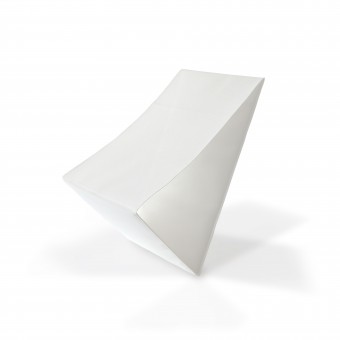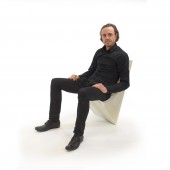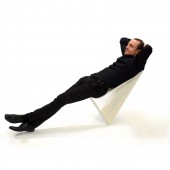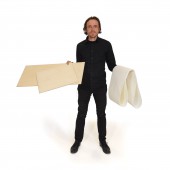
| THE AWARD |
| CATEGORIES |
| REGISTRATION |
| SUBMIT YOUR WORK |
| ENTRY INSTRUCTIONS |
| TERMS & CONDITIONS |
| PUBLICATIONS |
| DATES & FEES |
| METHODOLOGY |
| CONTACT |
| WINNERS |
| PRESS ROOM |
| GET INVOLVED |
| DESIGN PRIZE |
| DESIGN STORE |
| THE AWARD | JURY | CATEGORIES | REGISTRATION | PRESS | WINNERS | PUBLICATIONS | ENTRY INSTRUCTIONS |
Check Folding Chair by Thomas Rauscher |
Home > Winners > Design #55040 >Interview |
 |
|
FS: What is the main principle, idea and inspiration behind your design?
TR: At some point I noticed I was tilting most of the time when working at my desk. This was the starting point and therefore the main principle behind the design - designing chairs that provide only two legs or one skid, so the person sitting on them have to balance. The idea of folding chair was a sketch - showing an outline, describing a volume. Looking at it a few weeks later I had a hunch, that it might also work only "using the outline". A first prototype of two thick panes, a piece of carpet and some staples as connectors proofed it right.
FS: What has been your main focus in designing this work? Especially what did you want to achieve?
TR: The main focus on most of my works are two aspects - questioning / altering common design and the reduction of an idea to its bare minimum.
FS: What are your future plans for this award winning design?
TR: This design is really simple, even unskilled persons can use it to manufacture a chair of his / her own. So I decided to treat it as a kind of open source - I will make the idea / desing and its construction plans, as well as material suggestions accessible on my website for everyone.
FS: How long did it take you to design this particular concept?
TR: The amount of time cannot be estimated, as designing this chair was not based on a contract with a client. It was more of a process with many breaks. The basic idea of reducing a chair to only one seat and two legs underneath it came up in 2011. I used this concept for some designs, I made many sketches how chairs might look like taking use of this principle. The idea of this folding chair was a simple Heureka - by noticing, that outline of sketches do not imply showing a volume, but can also be treated as hollow objects. Building a first prototype was only a matter of minutes.
FS: Why did you design this particular concept? Was this design commissioned or did you decide to pursuit an inspiration?
TR: One of the main principles of designing things is questioning the status - do things have to look like they alway do, do we have to use things like we always in the same manner? The design of this chair gives such an answer. It is simply a result of looking for innovation.
FS: Is your design being produced or used by another company, or do you plan to sell or lease the production rights or do you intent to produce your work yourself?
TR: Neither of the suggestions - it will be public to anyone to use it, to alter it, to improve it.
FS: What made you design this particular type of work?
TR: simply curiosity and a strong belief, that there are other ways to design even simple products like chairs in a completely different way
FS: Where there any other designs and/or designers that helped the influence the design of your work?
TR: no
FS: Who is the target customer for his design?
TR: anyone who likes this idea, anyone who also tries to see the world with different eyes
FS: What sets this design apart from other similar or resembling concepts?
TR: its simlicity, the constructional integration of the person sitting on this chair, its low - cost production, its new way of sitting, it can be collapsed to a thickness of below 20 mm, and so on
FS: How did you come up with the name for this design? What does it mean?
TR: some websites ask you to approve certain content by clicking on a check - box. The check is a hook, consisting of a smaller and a longer line, connected at the bottom - quite similar to the panels of the chair.
FS: Which design tools did you use when you were working on this project?
TR: pen, paper, various types of panels and fabric - means no computer
FS: What is the most unique aspect of your design?
TR: its different from all the other chairs
FS: Who did you collaborate with for this design? Did you work with people with technical / specialized skills?
TR: no
FS: What is the role of technology in this particular design?
TR: keep it as simple as possible, so anyone can produce the chair
FS: Is your design influenced by data or analytical research in any way? What kind of research did you conduct for making this design?
TR: The design of the folding chair was not based on analytic thoughts, it was more of a accidental one. Once the idea of using only two panels and a piece of fabric came up I build a first prototype, using very stiff materials like 19 mm plywood and carpet. Downsizing these materials to a required minimum and experimenting with different proportions of the part were the only research.
FS: What are some of the challenges you faced during the design/realization of your concept?
TR: The challenge was not the process of designing the chair itself, this worked merely automatically, as it was only a simple reduction to the core. The greatest challenge some conservative thoughts of people I asked for their opinion on this chair - getting answers like this chair does not work, you can fall off it easily, it does not look like a chair, it does not stand by its own, and so on.
FS: How did you decide to submit your design to an international design competition?
TR: I wanted to go public with this idea to get feedback. To do so submitting it to an international design competition gives you a great opportunity and many viewers.
FS: What did you learn or how did you improve yourself during the designing of this work?
TR: The basic experience was a simple fact - even a simple sketch could be seen in different ways - as volumes or as outlines. This might change an idea completely.
FS: Any other things you would like to cover that have not been covered in these questions?
TR: no
FS: Thank you for providing us with this opportunity to interview you.
A' Design Award and Competitions grants rights to press members and bloggers to use parts of this interview. This interview is provided as it is; DesignPRWire and A' Design Award and Competitions cannot be held responsible for the answers given by participating designers.
| SOCIAL |
| + Add to Likes / Favorites | Send to My Email | Comment | View Press-Release |




